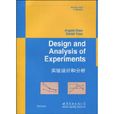內容簡介
《實驗設計和分析》主要內容包括:Principles and Techniques、Design: Basic Principles and Techniques、The Art of Experimentation、Replication、Blocking、Randomization、Analysis: Basic Principles and Techniques、Planning Experiments、A Checklist for Planning Experiments、Real Experiment——Cotton-Spinning Experiment等等。
圖書目錄
Preface
1. Principles and Techniques
1.1. Design: Basic Principles and Techniques
1.1.1. The Art of Experimentation
1.1.2. Replication
1.1.3. Blocking
1.1.4. Randomization
1.2. Analysis: Basic Principles and Techniques
2. Planning Experiments
2.1. Introduction
2.2. A Checklist for Planning Experiments
2.3. A Real Experiment——Cotton-Spinning Experiment
2.4. Some Standard Experimental Designs
2.4.1. Completely Randomized Designs
2.4.2. Block Designs
2.4.3. Designs with Two or More Blocking Factors
2.4.4. Split-Plot Designs
2.5. More Real Experiments
2.5.1. Soap Experiment
2.5.2. Battery Experiment
2.5.3. Cake-Baking Experiment
Exercises
3. Designs with One Source of Variation
3.1. Introduction
3.2. Randomization
3.3. Model for a Completely Randomized Design
3.4. Estimation of Parameters
3.4.1. Estimable Functions of Parameters
3.4.2. Notation
3.4.3. Obtaining Least Squares Estimates
3.4.4. Properties of Least Squares Estimators
3.4.5. Estimation ofo2
3.4.6. Confidence Bound for ~r2
3.5. One-Way Analysis of Variance
3.5.1. Testing Equality of Treatment Effects
3.5.2. Use of p-Values
3.6. Sample Sizes
3.6.1. Expected Mean Squares for Treatments
3.6.2. Sample Sizes Using Power of a Test
3.7. A Real Experiment——-Soap Experiment, Continued
3.7.1. Checklist, Continued
3.7.2. Data Collection and Analysis
3.7.3. Discussion by the Experimenter
3.7.4. Further Observations by the Experimenter
3.8. Using SAS Software
3.8.1. Randomization
3.8.2. Analysis of Variance
Exercises
4. Inferences for Contrasts and Treatment Means
4.1. Introduction
4.2. Contrasts
4.2.1. Pairwise Comparisons
4.2.2. Treatment Versus Control
4.2.3. Difference of Averages
4.2.4. Trends
4.3. Individual Contrasts and Treatment Means
4.3.1. Confidence Interval for a Single Contrast
4.3.2. Confidence Interval for a Single Treatment Mean
4.3.3. Hypothesis Test for a Single Contrast or Treatment Mean
4.4. Methods of Multiple Comparisons
4.4.1. Multiple Confidence Intervals
4.4.2. Bonferroni Method for Preplanned Comparisons
4.4.3. Scheff6 Method of Multiple Comparisons
4.4.4. Tukey Method for All Pairwise Comparisons
4.4.5. Dunnett Method for Treatment-Versus-Control Comparisons
4.4.6. Hsu Method for Multiple Comparisons with the Best
reatment
4.4.7. Combination of Methods
4.4.8. Methods Not Controlling Experimentwise Error Rate
4.5. Sample Sizes
4.6. Using SAS Software
4.6.1. Inferences on Individual Contrasts
4.6.2. Multiple Comparisons
Exercises
5. Checking Model Assumptions
5.1. Introduction
5.2. Strategy for Checking Model Assumptions
5.2.1. Residuals
5.2.2. Residual Plots
5.3. Checking the Fit of the Model
5.4. Checking for Outliers
5.5. Checking Independence of the Error Terms
5.6. Checking the Equal Variance Assumption
5.6.1. Detection of Unequal Variances
5.6.2. Data Transformations to Equalize Variances
5.6.3. Analysis with Unequal Error Variances
5.7. Checking the Normality Assumption
5.8. Using SAS Software
5.8.1. Using SAS to Generate Residual Plots
5.8.2. Transforming the Data
Exercises
6. Experiments with Two Crossed Treatment Factors
6.1. Introduction
6.2. Models and Factorial Effects
6.2.1. The Meaning of Interaction
6.2.2. Models for Two Treatment Factors
6.2.3. Checking the Assumptions on the Model
6.3. Contrasts
6.3.1. Contrasts for Main Effects and Interactions
6.3.2. Writing Contrasts as Coefficient Lists
6.4. Analysis of the Two-Way Complete Model
6.4.1. Least Squares Estimators for the Two-Way Complete Model
6.4.2. Estimation ofo~ for the Two-Way Complete Model
6.4.3. Multiple Comparisons for the Complete Model
6.4.4. Analysis of Variance for the Complete Model
6.5. Analysis of the Two-Way Main-Effects Model
6.5.1. Least Squares Estimators for the Main-Effects Model
6.5.2. Estimation ofa2 in the Main-Effects Model
6.5.3. Multiple Comparisons for the Main-Effects Model
6.5.4. Unequal Variances
6.5.5. Analysis of Variance for Equal Sample Sizes
6.5.6. Model Building
6.6. Calculating Sample Sizes
6.7. Small Experiments
6.7.1. One Observation per Cell
6.7.2. Analysis Based on Orthogonal Contrasts
6.7.3. Tukey's Test for Additivity
6.7.4. A Real Experiment——Air Velocity Experiment
6.8. Using SAS Software
6.8.1. Contrasts and Multiple Comparisons
6.8.2. Plots
6.8.3. One Observation per Cell
Exercises
7. Several Crossed Treatment Factors
7.1. Introduction
7.2. Models and Factorial Effects
7.2.1. Models
7.2.2. The Meaning of Interaction
7.2.3. Separability of Factorial Effects
7.2.4. Estimation of Factorial Contrasts
7.3. Analysis——Equal Sample Sizes
7.4. A Real Experiment——Popcorn-Microwave Experiment
7.5. One Observation per Cell
7.5.1. Analysis Assuming That Certain Interaction Effects Are egligible
7.5.2. Analysis Using Normal Probability Plot of Effect Estimates
7.5.3. Analysis Using Confidence Intervals
7.6. Design for the Control of Noise Variability
7.6.1. Analysis of Design-by-Noise Interactions
7.6.2. Analyzing the Effects of Design Factors on Variability .
7.7. Using SAS Software
7.7.1. Normal Probability Plots of Contrast Estimates
7.7.2. Voss-Wang Confidence Interval Method
7.7.3. Identification of Robust Factor Settings
7.7.4. Experiments with Empty Cells
Exercises
8. Polynomial Regression
8.1. Introduction
8.2. Models
8.3. Least Squares Estimation (Optional)
8.3.1. Normal Equations
……
9. Analysis of Covariance
10. Complete Block Designs
11. Incomplete Block Designs
12. Designs with Two Blocking Factors
13. Confounded Two-Level Factorial Experiments
14. Confounding in General Factorial Experiments
15. Fractional Factorial Experiments
16. esponse Surface Methodology
17. andom Effects and Variance Components
18. estde Models
19. plit-Plot Designs
A. ables
Bibliography
Index of Authors
Index of Experiments
Index of Subjects

